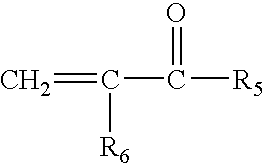Polyoxyalkylene siloxane copolymers with antistatic properties and their application to fiberglass insulation and other substrates
a technology of polyoxyalkylene siloxane and copolymer composition, which is applied in the direction of layered products, transportation and packaging, chemical instruments and processes, etc., can solve the problems of reducing the conductivity of electrostatic charge, and reducing the usefulness of fiberglass insulation, etc., to achieve easy application, reduce the charge of the electrostatic surface, and reduce the charge of the surface.
- Summary
- Abstract
- Description
- Claims
- Application Information
AI Technical Summary
Benefits of technology
Problems solved by technology
Method used
Image
Examples
example 1
[0022]Deionized water (550 g) was added to a vessel equipped with agitation, nitrogen supply, heating and cooling. To this acrylic acid (39.7 g) was added followed by 50% acrylamide (79.4 g) and the Dow Corning Q4-3667 linear polyoxyalkylene siloxane acrylate (26.5 g). This stirred solution was sparged with N2 at room temperature to remove dissolved oxygen. Ammonium persulfate (7.7 g) and sodium metabisulfite (6.5 g) were added to the stirred monomer mixture. The polymerization reaction was exothermic. The resulting polymer was neutralized with 50% NaOH, then filtered and the product collected. The polyoxyalkylene siloxane copolymer had a viscosity of about 60 cP.
example 2
[0023]Deionized water (550 g) was added to a vessel equipped with agitation, nitrogen supply, heating and cooling. To this acrylic acid (39.7 g) was added followed by 50% acrylamide (79.4 g) and the Dow Corning Q4-3667 Fluid (26.5 g). This stirred solution was sparged with N2 at room temperature to remove dissolved oxygen. Ammonium persulfate (10.36 g) and sodium metabisulfite (8.7 g) were added to the stirred monomer mixture. The polymerization reaction was exothermic. The resulting polymer was neutralized with 50% NaOH, then filtered and the product collected. The polyoxyalkylene siloxane copolymer had a viscosity of about 45 cP.
example 3
[0024]Deionized water (75 parts) was added to a vessel equipped with agitation, nitrogen supply, heating and cooling. To this acrylic acid (5.3 parts) was added followed by 50% acrylamide (5.3 parts) and the Dow Corning Q4-3667 Fluid (3.5 parts). This stirred solution was sparged with N2 at room temperature to remove dissolved oxygen. Ammonium persulfate (1 parts) and sodium metabisulfite (0.9 parts) were added to the stirred monomer mixture. The polymerization reaction was exothermic. The resulting polymer was neutralized with 50% NaOH, then filtered and the product collected. The polyoxyalkylene siloxane copolymer had a viscosity of about 38 cP.
PUM
| Property | Measurement | Unit |
|---|---|---|
| viscosity | aaaaa | aaaaa |
| viscosity | aaaaa | aaaaa |
| viscosities | aaaaa | aaaaa |
Abstract
Description
Claims
Application Information
 Login to View More
Login to View More - R&D
- Intellectual Property
- Life Sciences
- Materials
- Tech Scout
- Unparalleled Data Quality
- Higher Quality Content
- 60% Fewer Hallucinations
Browse by: Latest US Patents, China's latest patents, Technical Efficacy Thesaurus, Application Domain, Technology Topic, Popular Technical Reports.
© 2025 PatSnap. All rights reserved.Legal|Privacy policy|Modern Slavery Act Transparency Statement|Sitemap|About US| Contact US: help@patsnap.com



